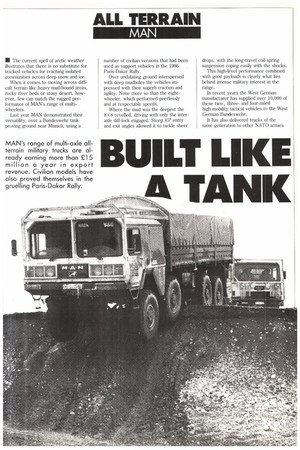BUILT LIKE A TANK
Page 31

Page 32

If you've noticed an error in this article please click here to report it so we can fix it.
• The current spell of arctic weather illustrates that there is no substitute for tracked vehicles for reaching isolated communities across deep snow and ice.
When it comes to moving across difficult terrain like heavy mud-bound areas, rocky river beds or stony desert, however, few can match the rugged performance of MAN's range of multiwheelers.
Last year MAN demonstrated their versatility, over a Bundeswehr tank proving ground near Munich, using a number of civilian versions that had been used as support vehicles in the 1986 Paris-Dakar Rally.
Over undulating ground interspersed with deep mudholes the vehicles impressed with their superb traction and agility. None more so than the eightwheeler, which performed peerlessly and at respectable speeds.
Where the mud was the deepest the 8x8 revelled, driving with only the interaxle diff-lock engaged. Steep 45° entry and exit angles allowed it to tackle sheer drops, with the long-travel coil-spring suspension coping easily with the shocks.
This high-level performance combined with good payloads is clearly what lies behind intense military interest in the range.
In recent years the West German manufacturer has supplied over 10,000 of these two-, threeand four-axled high-mobility tactical vehicles to the West German Bundeswehr.
It has also delivered trucks of the same generation to other NATO armies in Europe, including Canada's contingent. Last year MAN strengthened that link and its association with General Motors with an agreement to build a further 500 vehicles in Canada for the Canadian armed forces.
This followed a similar deal with GM's Detroit-based military vehicle operation earlier last year which resulted in a contract to supply the US army with 500 of the latest generation of MAN's allwheel-drive military trucks for deployment in Europe and America.
With the average price of a military version set at around DM230,000 (k82,700) MAN's turnover from such cooperative agreements is on the increase and is currently worth around DM420 million (E15.1 million) — about 10% of its overall turnover.
For military purposes they are offered in three groups, according to payload capacity. A two-wded version has a five tonne rating, a three-axle truck has seven tonnes while the heavier eightwheeler can carry a ten tonne payload. Power is supplied by either a Deutz or MAN 12.7 litre, vee-eight engine with the air-cooled unit being specified by the West German army.
While the optional MAN engine is included with the Canadian army contract, the US army vehicles will use GM Detroit Diesel units of a similar power rating.
The 4 x4 variants have a choice of the 179kW naturally-aspirated, the 216kW turbocharged, or the 246kW intercooled versions of the in-line six engine.
Three-wded MANs share the 216kW and 235kW intercooled vee-eight, which is also used in the 8x8 model along with the most powerful naturally-aspirated 272kW vee-10 engine. All military models have ZFS6-90 six-speed synchromesh gearboxes with integral torque converter clutches and two-speed transfer boxes.
On the 8x8 the transfer case is remotely-mounted and propshaft-driven. Hub reduction gears are used throughout the range.
In addition to the torque cnvertor, MAN fits a free-wheel device that allows tow-starting.
For its high-mobility trucks, MAN uses a low torsion frame. Its steel, closedbox-section main members have weldedon tubular-section cross-members. this not only minimises twisting but on last year's Paris-Dakar Rally allowed MAN to use short lengths of the 4 x4 entry's frame as air reservoirs, thus saving on weight.
Axles have locating arms and long-travel progressively-acting helical coil springs with hydraulic dampers. These maintain good ground contact over rough terrain.
Although these tactical vehicles were initially designed to follow and support class 1 Leopard tanks at speeds of around 40km/h they are, of course, capable of much higher speeds depending on final drive ratios and tyre sizes.
They have limited civilian use, generally in support of public utilities or emergency services.
However many demonstrations MAN may have given, there can have been no better opportunity to show off their capabilities than their participation in the Paris-Dakar rally.
ADVENTURES
Many regard the 14,000km dash across southern Europe and northwest Africa as one of the last great adventures in motor rallying. For manufacturers like MAN, however, it is more than just an exciting escapade, for a winning performance could well boost vehicle sales.
Over the past eight years several of MAN's two-threeand four-axled highmobility trucks have taken part in the rally as competing supply vehicles, with great success.
One of the quirks of this demanding event is that competitors may not be supplied by air or from pre-arranged depots, but they can get help from back-up vehicles. These are registered as official race entries and are subjected to the same extreme conditions and time restrictions as 'normal' competitors, but serve a dual purpose, so trucks equipped for off-road conditions and with high payload capacities play a major role in the rally.
In the eight rallies to date, MAN has supported Porsche, Opel and BMW (even Austin Rover last year) and finished high up the list of supply vehicle competitors. In this year's rally, which is currently underway, Lada, Toyota and French-entered Range Rovers are also being supported, and retrieved when needed.
Having played a key role in backing up light vehicle entrants, they have earned themselves a high reputation for the performance and reliability that is vital for the military.
0 by Bryan Jarvis








































































































